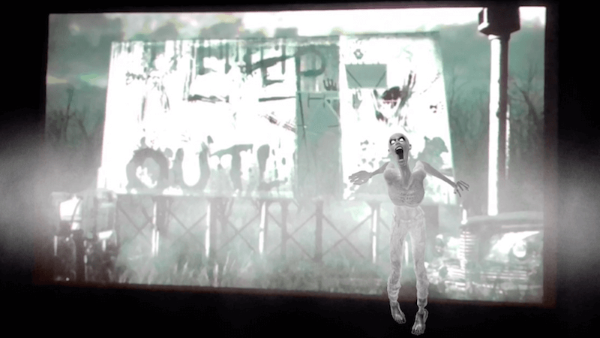[Halloween presence! This story from MarTech Today describes a new use of augmented reality in movie theaters, and in particular a new “Halloween Experience” available until the holiday next week. See the original version of the story to watch the 0:45 minute video trailer. Other coverage notes that you can play at home if you download the Noovie Arcade app. For a related example of AR scariness, see a story from earlier this year in ScreenRant (or go directly to Abhishek Singh’s Twitter page). –Matthew]

An AR Halloween pre-show invades movie theaters
National Cinemedia started employing augmented reality in thousands of theaters last spring, and is now launching its first one for ghosts’ favorite holiday.
Barry Levine
October 10, 2018
Now in movie theaters in the US and Canada: an augmented reality (AR) Halloween-inspired experience before the feature film.
Called the Noovie ARcade Halloween Experience, it will be available through Halloween night by National Cinemedia, which describes itself as the largest cinema advertising network in North America.
Invading 20,800 screens. The rollout covers 20,800 screens in the US and Canada — some running horror films, others non-Halloween PG-13 or R-rated fare — in over 1650 theaters managed by AMC, Cinemark, Regal Entertainment Group and dozens of local exhibitors.
To participate in the Halloween experience, a moviegoer downloads and opens National Cinemedia’s free iOS or Android Noovie ARcade app and points her smartphone at the screen when prompted. A visual trigger on the screen shows a 35-second playthrough AR experience seen through the phone and superimposed over the theater screen.
While this is National Cinemedia’s first Halloween-related AR experience, it’s not its first AR.
The Noovie ARcade app was launched this past spring and has since been downloaded about a million times. National Cinemedia has previously created and released for the app four original AR games that moviegoers can play on their phones, with interactive gameplay seen over a theater’s setting.
In Cinevaders, for instance, a worm hole opens in the theater, aliens pour out and the user protects fellow moviegoers by destroying the un-humans with lasers.
No advertising yet, except on leaderboard. While there is no team play or ads in the games, users can view a branded leaderboard when the game ends.
Like the Halloween playthrough, the interactive AR games have a time out so moviegoers are not distracting others during the film. Additionally, vice president of digital ad sales Jerry Canning said, the Halloween experience and the games are followed by an on-screen request to silence and put away smartphones.
National Cinemedia’s main business is creating and distributing various kinds of pre-show content that plays before the main feature, such as ads and behind-the-scenes shorts.
Canning told me that there are no stats yet on whether the AR activities increase any metric that advertisers or theater owners would find useful, adding that his company sees this effort as a way to diversify its content and test the technology for its ability to capture theatergoers’ attention.
Like the games, the Halloween experience doesn’t currently include ads, but Canning said his company was exploring integrated marketing for all its AR properties, such as its cannon game shooting M&Ms.
Why this matters to marketers. To his knowledge, he said, these experiences and games are the first sustained AR experiences in movie theaters, tied to imagery shown on a theater’s screen.
Other movie-related AR efforts, he noted, include the “augmented reality movie magazine” Moviebill that is triggered by imagery in its printed material, and a Pokemon Go-like AR discovery game by the makers of the Jurassic Park movies.
Now that AR can play on any recent smartphone or tablet, its use in entertainment marketing and in storytelling is positioned to boom. Movie theaters, in particular, could blossom into AR arcades before, after and even during films, since virtually all patrons have the required gear, theaters provide great settings that can be triggered by any kind of imagery on the screen, and everyone is there to be wowed.
In fact, AR experiences could turn into a regular differentiator for movie theaters, which are struggling to compete with the high-definition, surround sound presentations of hundreds of programming sources that many people already enjoy at home. As with the recent use of AR by USA Today to promote a podcast, this format provides a way to reveal hidden dimensions of reality that can offer a different way of looking at an event or a product.